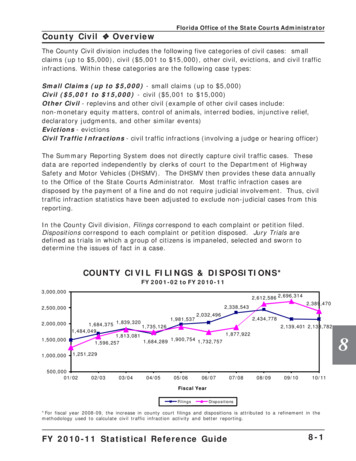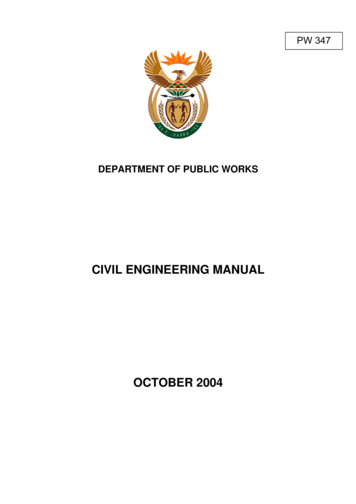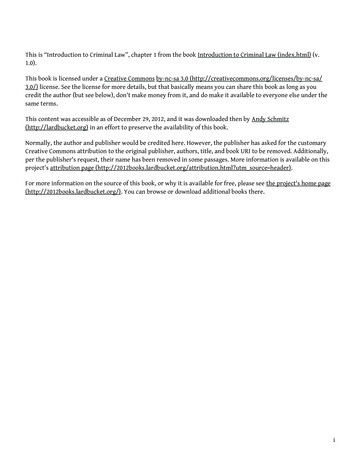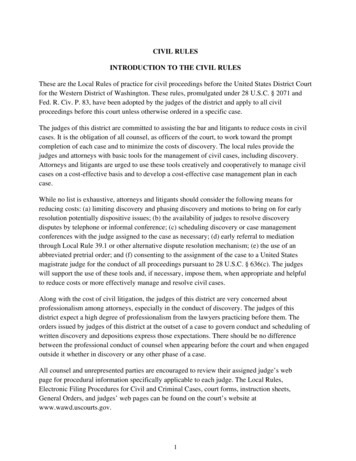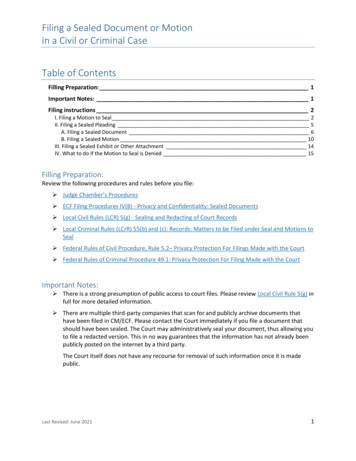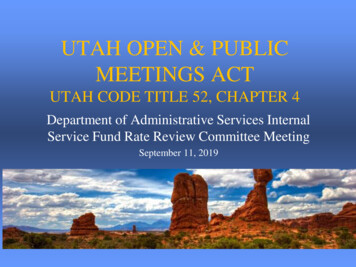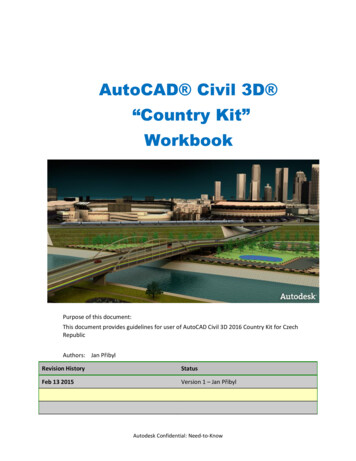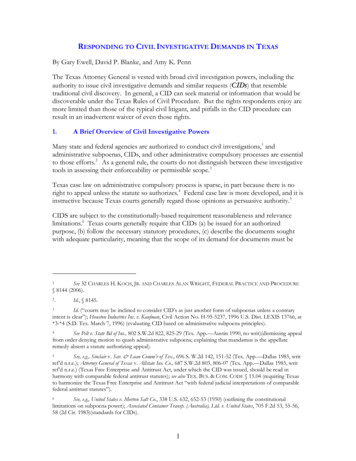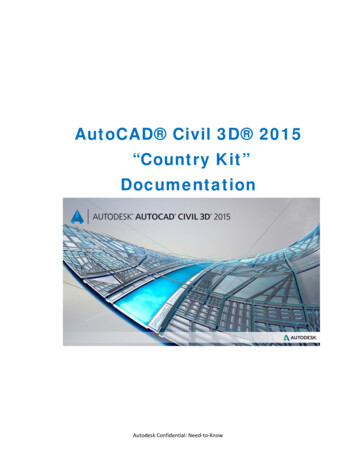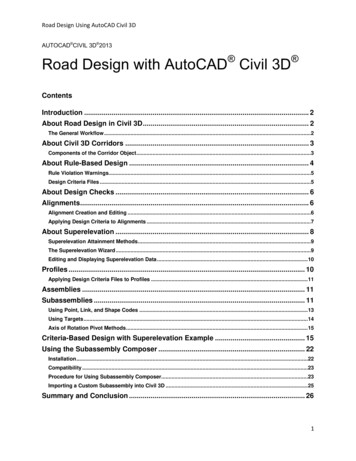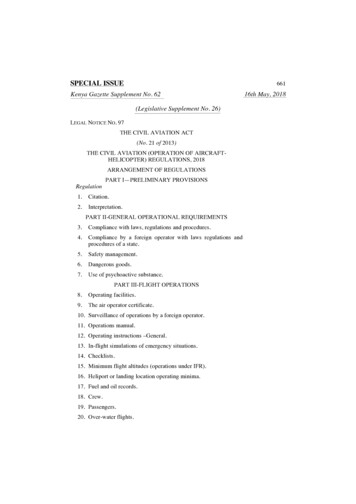
Transcription
SPECIAL ISSUE661Kenya Gazette Supplement No. 62(Legislative Supplement No. 26)LEGAL NOTICE NO. 97THE CIVIL AVIATION ACT(No. 21 of 2013)THE CIVIL AVIATION (OPERATION OF AIRCRAFTHELICOPTER) REGULATIONS, 2018ARRANGEMENT OF REGULATIONSPART I—PRELIMINARY RT II-GENERAL OPERATIONAL REQUIREMENTS3.Compliance with laws, regulations and procedures.4.Compliance by a foreign operator with laws regulations andprocedures of a state.5.Safety management.6.Dangerous goods.7.Use of psychoactive substance.PART III-FLIGHT OPERATIONS8.Operating facilities.9.The air operator certificate.10. Surveillance of operations by a foreign operator.11. Operations manual.12. Operating instructions –General.13. In-flight simulations of emergency situations.14. Checklists.15. Minimum flight altitudes (operations under IFR).16. Heliport or landing location operating minima.17. Fuel and oil records.18. Crew.19. Passengers.20. Over-water flights.16th May, 2018
662Kenya Subsidiary Legislation, 201821. Flight preparation.22. Operational flight planning.23. Alternate heliports.24. Meteorological conditions.25. Fuel and oil requirements.26. Refuelling with passengers on board or rotors turning.27. Oxygen supply.28. Heliport operating minima.29. Meteorological observations.30. Hazardous flight conditions.31. Flight crew members at duty stations.32. Use of oxygen.33. Safeguarding of cabin crew and passengers in pressurizedaircraft in the event of loss of pressurization.34. Instrument flight procedures.35. Helicopter operating procedures for noise abatement.36. In-flight fuel management.37. Duties of pilot-in-command.38. Duties of flight operations officer/flight dispatcher.39. Carry-on baggage.PART IV-HELICOPTER PERFORMANCE OPERATINGLIMITATIONS40. General provisions.41. Applicable to helicopters certificated in accordance with theCivil Aviation (Airworthiness) Regulations.42. Mass limitation.43. Obstacle data.44. Additional requirements for operations of helicopters inperformance class 3 in IMC, except special VFR flights.PART V-HELICOPTER INSTRUMENTS, EQUIPMENT, ANDFLIGHT DOCUMENTS45. General.46. All helicopters on all flights.47. All helicopters on flights over water: Means of floatation.48. All helicopters on flights over designated sea areas.49. All helicopters on high altitude flights.
Kenya Subsidiary Legislation, 201850. All helicopters in icing conditions.51. Noise certification.52. Helicopters carrying passengers-cabin crew seats.53. Microphones.54. Helicopters equipped with automatic landing systems, a headup display (HUD)or equivalent displays, enhanced visionsystems (EVS), synthetic vision systems (SVS) or combinedvision systems (CVS).55. Electronic Flight Bag (EFB) equipment.56. EFB functions.57. EFB operational approval.PART VI-HELICOPTER COMMUNICATION, NAVIGATION ANDSURVEILLANCE EQUIPMENT58. Communication equipment.59. Navigation equipment.60. Surveillance equipment.61. Electronic navigation data management.PART VII-HELICOPTER FLIGHT CREW62. Composition of the flight crew.63. Flight crew member emergency duties.64. Flight crew member training programes.PART VIII - QUALIFICATIONS65. Recent experience: Pilot in command and co-pilot.66. Pilot-in-command operational qualification.67. Pilot proficiency checks.68. Flight crew equipment.69. Flight time, flight duty periods and rest periods.PART IX-FLIGHT OPERATIONS OFFICER /FLIGHTDISPATCHER70. Qualifications and trainingPART X-MANUALS, LOGS AND RECORDS71. Flight manual.72. Operator’s maintenance control manual.73. Maintenance programme.74. Records of emergency and survival equipment carried.75. Flight recorder records.663
664Kenya Subsidiary Legislation, 2018PART XI-CABIN CREW76. Assignment of emergency duties.77. Protection of cabin crew during flight.78. Training.79. Flight time, flight duty periods and rest periods.PART XII-INSTRUCTOR AND CHECK PERSONNELQUALIFICATIONS AND TRAINING80. Instructor qualifications–flightoperations officer.crew,cabincrew,flight81. Instructor training.82. Personnel approved to conduct checks.83. Check personnel qualifications: Flight crew training.84. Check tional85. Check personnel for Cabin crew.86. Check personnel for Flight operations officers.87. Check personnel training.88. Monitoring of training and checking activities.89. Termination of proficiency: Competency or line check.PART XIII- HELICOPTER MAINTENANCE - COMMERCIAL90. Operators maintenance control manual.91. Maintenance programme.92. Maintenance of records.PART XIV-HELICOPTER –GENERAL AVIATIONGeneral93. Compliance with laws, regulations and procedures.94. Dangerous goods.95. Use of psychoactive substances.96. Specific approvals.Flight Operations97.Adequacy of operating facilities.98.Heliport or landing location operating minima.99.Briefing.100. Helicopter airworthiness and safety precautions.101. Weather reports and forecasts.
Kenya Subsidiary Legislation, 2018102. Limitations imposed by weather conditions VFR, IFR.103. Alternate heliports.104. Fuel and oil requirements.105. In-flight fuel management.106. Oxygen supply.107. Use of oxygen.108. In-flight emergency instruction.109. Weather reporting by pilots.110. Hazardous flight conditions.111. Fitness of flight crew members.112. Flight crew members at duty stations.113. Instrument flight procedures.114. Instruction — general.115. Refuelling with passengers on board or rotors turning.116. Over-water flights.Helicopter performance117. Operating limitations.Helicopter maintenance118. Maintenance responsibilities.119. Maintenance records.120. Continuing airworthiness information.121. Modifications and repairs.122. Certificate of release to service.Helicopter Flight Crew123. Qualifications.124. Composition of the flight crew.PART XVI-EXEMPTIONS, GENERAL PROVISIONS, OFFENCESAND PENALTIESExemptions125. Applicability.126. Requirement for application.127. Request for exemption -Review, Publication and Issue orDenial of the Exemption.128. Initial review by the Authority.129. Evaluation of the request.665
666Kenya Subsidiary Legislation, 2018General provisions130. Possession of the licence.131. Drug and alcohol testing and reporting.132. Inspection of licences and certificates.133. Change of name.134. Change of address.135. Replacement of documents.136. Certificate Suspension and Revocations.137. Use and retention of certificates and records.138. Reports of violation.139. Enforcement of directions.140. Aeronautical user fees.141. Application of regulations to Government and visiting forces,etc.142. Extra-territorial application of Regulations.143. Flights over any foreign country.144. Contravention of Regulations.145. Appeals to the Tribunal.146. Offences and Penalties.147. Revocation.148. TransitionalSCHEDULESFirst ScheduleSecond ScheduleThird ScheduleFourth ScheduleFifth ScheduleSixth Schedule
Kenya Subsidiary Legislation, 2018667THE CIVIL AVIATION ACT(No. 21 of 2013)IN EXERCISE of powers conferred by section 82 of the CivilAviation Act, 2013, the Cabinet Secretary for Transport, Infrastructure,Housing and Urban Development makes the following Regulations—THE CIVIL AVIATION (OPERATION OF AIRCRAFTHELICOPTER) REGULATIONS, 2018PART I—PRELIMINARY PROVISIONS1. These Regulations may be cited as the Civil Aviation(Operation of Aircraft -Helicopter) Regulations 2018.Citation.2. In these Regulations, unless the context otherwiserequires—Interpretation.“Act” means the Civil Aviation Act, 2013;“Aerial work” means an aircraft operation in which an aircraft isused for specialized services such as agriculture, construction,photography, surveying, observation and patrol, search and rescue,aerial advertisement, etc;“Aerodrome” means a defined area on land or water (includingany buildings, installations and equipment) intended to be used eitherwholly or in part for the arrival, departure and surface movement ofaircraft;“Aircraft” means any machine that can derive support in theatmosphere from the reactions of the air other than the reactions of theair against the earth’s surface;“Aircraft operating manual” means a manual, acceptable to theAuthority, containing normal, abnormal and emergency procedures,checklists, limitations, performance information, details of the aircraftsystems and other material relevant to the operation of the aircraft;“Air Operator Certificate (AOC)” means a certificate authorizingan operator to carry out specified commercial air transport operations;“Air Traffic Service (ATS)” is a generic term meaning variously,flight information service, alerting service, air traffic advisory service,air traffic control service (area control service, approach control serviceor aerodrome control service);“Airworthy” means the status of an aircraft, engine, propeller orpart when it conforms to its approved design and is in a condition forsafe operation;“Alternate heliport” means a heliport to which a helicopter mayproceed when it becomes either impossible or inadvisable to proceed toor to land at the heliport of intended landing where the necessaryservices and facilities are available, where aircraft performancerequirements can be met and which is operational at the expected timeof use. Alternate heliports include the following—
668Kenya Subsidiary Legislation, 2018(a) “Take-off alternate” means an alternate heliport at which ahelicopter would be able to land should this becomenecessary shortly after take-off and it is not possible to usethe heliport of departure;(b) En-route alternate. An alternate heliport at which ahelicopter would be able to land in the event that a diversionbecomes necessary while en route;(c) Destination alternate. An alternate heliport at which ahelicopter would be able to land should it become eitherimpossible or inadvisable to land at the heliport of intendedlanding;“Approach and landing phase — helicopters” means that part ofthe flight from 300 m (1 000 ft) above the elevation of the FATO, if theflight is planned to exceed this height, or from the commencement ofthe descent in the other cases, to landing or to the balked landing point;“Area Navigation (RNAV)” means a method of navigationwhich permits aircraft operation on any desired flight path within thecoverage of ground- or space-based navigation aids or within the limitsof the capability of self-contained aids, or a combination of these;“Cabin crew member” means crew member who performs, in theinterest of safety of passengers, duties assigned by the operator or thepilot-in-command of the aircraft, but who shall not act as a flight crewmember;“Certificate of release to service” means a document whichcontains a certification confirming that the maintenance work to whichit relates has been completed in a satisfactory manner, either inaccordance with the approved data and the procedures described in themaintenance organization’s procedures manual or under an equivalentsystem;“Combined Vision System (CVS)” means a system to displayimages from a combination of an enhanced vision system (EVS) and asynthetic vision system (SVS);“Commercial air transport operation” means an aircraft operationinvolving the transport of passengers, cargo or mail for remuneration orhire;“Configuration Deviation List (CDL)” means a list establishedby the organization responsible for the type design with the approval ofthe State of Design which identifies any external parts of an aircrafttype which may be missing at the commencement of a flight, and whichcontains, where necessary, any information on associated operatinglimitations and performance correction;“Congested area” means in relation to a city, town or settlement,any area which is substantially used for residential, commercial orrecreational purposes;“Congested hostile environment” means a hostile environmentwithin a congested area;
Kenya Subsidiary Legislation, 2018“Continuing airworthiness” means the set of processes by whichan aircraft, engine, rotor or part complies with the applicableairworthiness requirements and remains in a condition for safeoperation throughout its operating life;“Continuous Descent Final Approach (CDFA)” means atechnique, consistent with stabilized approach procedures, for flyingthe final approach segment of a non-precision instrument approachprocedure as a continuous descent, without level-off, from an altitudeor height at or above the final approach fix altitude or height to a pointapproximately 15 m (50 ft) above the landing runway threshold or thepoint where the flare manoeuvre should begin for the type of aircraftflown;“Contracting State” means all States that are parties to theConvention on International Civil Aviation (Chicago Convention);“Crew member” means a person assigned by an operator to dutyon an aircraft during a flight duty period;“Dangerous goods” means articles or substances which arecapable of posing a risk to health, safety, property or the environmentand which are shown in the list of dangerous goods in the TechnicalInstructions or which are classified according to those instructions;“Decision Altitude (DA) or Decision Height (DH)” means aspecified altitude or height in a three-dimensional (3D) instrumentapproach operation at which a missed approach must be initiated if therequired visual reference to continue the approach has not beenestablished;“Defined Point After Take-Off (DPATO)” means the point,within the take-off and initial climb phase, before which thehelicopter’s ability to continue the flight safely, with one engineinoperative, is not assured and a forced landing may be required;“Defined Point Before Landing (DPBL)” means the point, withinthe approach and landing phase, after which the helicopter’s ability tocontinue the flight safely, with one engine inoperative, is not assuredand a forced landing may be required;“Electronic Flight Bag (EFB)” means an electronic informationsystem, comprised of equipment and applications for flight crew, whichallows for the storing, updating, displaying and processing of EFBfunctions to support flight operations or duties;“Elevated heliport” means a heliport located on a raised structureon land;“Emergency Locator Transmitter (ELT)” means a generic termdescribing equipment which broadcast distinctive signals on designatedfrequencies and, depending on application, may be activatedautomatically on impact or be manually and an ELT may be any of thefollowing—(a) Automatic Fixed ELT (ELT(AF)). An automatically activatedELT which is permanently attached to an aircraft;669
670Kenya Subsidiary Legislation, 2018(b) Automatic Portable ELT (ELT(AP)). An automaticallyactivated ELT which is rigidly attached to an aircraft butreadily removable from the aircraft;(c) Automatic Deployable ELT (ELT(AD)). An ELT which isrigidly attached to an aircraft and which is automaticallydeployed and activated by impact, and, in some cases, alsoby hydrostatic sensors. Manual deployment is also provided;(d) Survival ELT (ELT(S)). An ELT which is removable from anaircraft, stowed so as to facilitate its ready use in anemergency, and manually activated by survivors;“Engine” means a unit used or intended to be used for aircraftpropulsion. It consists of at least those components and equipmentnecessary for functioning and control, but excludes the propeller/rotors(if applicable);“Enhanced Vision System (EVS)” means a system to displayelectronic real-time images of the external scene achieved through theuse of image sensors;“en-route phase” means that part of the flight from the end of thetake-off and initial climb phase to the commencement of the approachand landing phase;Note: Where adequate obstacle clearance cannot be guaranteedvisually, flights must be planned to ensure that obstacles can be clearedby an appropriate margin. In the event of failure of the critical engine,operators may need to adopt alternative procedures;“Final Approach and Take-Off area (FATO)” means a definedarea over which the final phase of the approach manoeuvre to hover orlanding is completed and from which the take-off manoeuvre iscommenced and where the FATO is to be used by helicopters operatingin performance Class 1, the defined area includes the rejected take-offarea available;“Final Approach Segment (FAS)” means that segment of aninstrument approach procedure in which alignment and descent forlanding are accomplished;“Flight crew member” means a licensed crew member chargedwith duties essential to the operation of an aircraft during a flight dutyperiod;“Flight duty period” means the total time from the moment aflight crew member commences duty, immediately subsequent to a restperiod and prior to making a flight or a series of flights, to the momentthe flight crew member is relieved of all duties having completed suchflight or series of flights;“Flight manual” means a manual, associated with the certificateof airworthiness, containing limitations within which the aircraft is tobe considered airworthy, and instructions and information necessary tothe flight crew members for the safe operation of the aircraft;
Kenya Subsidiary Legislation, 2018“Flight operations officer/flight dispatcher” means a persondesignated by the operator to engage in the control and supervision offlight operations, whether licensed or not, suitably qualified inaccordance with the Civil Aviation (Personnel) Licensing Regulations,who supports, briefs or assists the pilot-in-command in the safe conductof the flight;“Flight plan” means specified information provided to air trafficservices units, relative to an intended flight or portion of a flight of anaircraft;“Flight recorder” means any type of recorder installed in theaircraft for the purpose of complementing accident or incidentinvestigation;“Flight safety documents system” means a set of interrelateddocumentation established by the operator, compiling and organizinginformation necessary for flight and ground operations, andcomprising, as a minimum, the operations manual and the operator’smaintenance control manual;“Flight simulation training device” means any one of thefollowing three types of apparatus in which flight conditions aresimulated on the ground—(a) A flight simulator, which provides an accurate representationof the flight deck of a particular aircraft type to the extentthat the mechanical, electrical, electronic, etc. aircraftsystems control functions, the normal environment of flightcrew members, and the performance and flightcharacteristics of that type of aircraft are realisticallysimulated;(b) A flight procedures trainer, which provides a realistic flightdeck environment, and which simulates instrumentresponses, simple control functions of mechanical, electrical,electronic, etc. aircraft systems, and the performance andflight characteristics of aircraft of a particular class;(c) A basic instrument flight trainer, which is equipped withappropriate instruments, and which simulates the flight deckenvironment of an aircraft in flight in instrument flightconditions“Flight time — helicopters” means the total time from themoment a helicopter’s rotor blades start turning until the moment thehelicopter finally comes to rest at the end of the flight, and the rotorblades are stopped;“General aviation operation” means an aircraft operation otherthan a commercial air transport operation or an aerial work operation;“Ground handling” means services necessary for an aircraft’sarrival at, and departure from, an airport, other than air traffic services;“Head-Up Display (HUD)” means a display system that presentsflight information into the pilot’s forward external field of view;671
672Kenya Subsidiary Legislation, 2018“Helicopter” means a heavier-than-air aircraft supported in flightchiefly by the reactions of the air on one or more power-driven rotorson substantially vertical axes;“Helideck” means a heliport located on a floating or fixedoffshore structure;“Heliport” means an aerodrome or a defined area on a structureintended to be used wholly or in part for the arrival, departure andsurface movement of helicopters;“Heliport operating minima” means the limits of usability of aheliport for—(a) take-off, expressed in terms of runway visual range orvisibility and, if necessary, cloud conditions;(b) landing in 2D instrument approach operations, expressed interms of visibility or runway visual range, Minimum DescentAltitude/Height (MDA/H) and, if necessary, cloudconditions; and(c) landing in 3D instrument approach operations, expressed interms of visibility or runway visual range and DecisionAltitude/Height (DA/H) as appropriate to the type orcategory of the operation;“Hostile environment” means an environment in which—(a) a safe forced landing cannot be accomplished because thesurface and surrounding environment are inadequate;(b) the helicopter occupants cannot be adequately protected fromthe elements;(c) search and rescue response or capability is not providedconsistent with anticipated exposure; or(d) there is an unacceptable risk of endangering persons orproperty on the ground;“Human Factors principles” means principles which apply toaeronautical design, certification, training, operations and maintenanceand which seek safe interface between the human and other systemcomponents by proper consideration to human performance;“Human Performance” means human capabilities and limitationswhich have an impact on the safety and efficiency of aeronauticaloperations;“instrument approach operations” means an approach and landingusing instruments for navigation guidance based on an instrumentapproach procedure. There are two methods for executing instrumentapproach operations—(a) a two- dimensional (2D) instrument approach operation,using lateral navigation guidance only; and(b) a three-dimensional (3D) instrument approach operation,using both lateral and vertical navigation guidance;
Kenya Subsidiary Legislation, 2018“Instrument Approach Procedure (IAP)” means a series ofpredetermined manoeuvres by reference to flight instruments withspecified protection from obstacles from the initial approach fix, orwhere applicable, from the beginning of a defined arrival route to apoint from which a landing can be completed and thereafter, if alanding is not completed, to a position at which holding or en-routeobstacle clearance criteria apply. Instrument approach procedures areclassified as follows—(a) Non-Precision Approach (NPA) procedure An instrumentapproach procedure designed for 2D instrument approachoperations Type A;(b) Approach Procedure with Vertical guidance (APV). APerformance -Based Navigation (PBN) instrument approachprocedure designed for 3D instrument approach operationsType A;(c) Precision Approach (PA) procedure. An instrument approachprocedure based on navigation systems (ILS, MLS, GLS andSBAS CAT I) designed for 3D instrument approachoperations Type A or B;“Instrument Meteorological Conditions (IMC)”meansmeteorological conditions expressed in terms of visibility, distancefrom cloud, and ceiling, less than the minima specified for visualmeteorological conditions;“Integrated survival suit” means a survival suit which meets thecombined requirements of the survival suit and life jacket;“Landing Decision Point (LDP)” means the point used indetermining landing performance from which, an engine failureoccurring at this point, the landing may be safely continued or a balkedlanding initiated;“maintenance” means the performance of tasks required to ensurethe continuing airworthiness of an aircraft, including any one orcombination of overhaul, inspection, replacement, defect rectificationand the embodiment of a modification or repair;“Maintenance organization’s procedures manual” means adocument endorsed by the head of the maintenance organization whichdetails the maintenance organization’s structure and managementresponsibilities, scope of work, description of facilities, maintenanceprocedures and quality assurance or inspection systems;“Maintenance programme” means a document which describesthe specific scheduled maintenance tasks and their frequency ofcompletion and related procedures, such as a reliability programme,necessary for the safe operation of those aircraft to which it applies;“Master Minimum Equipment List (MMEL)” means a listestablished for a particular aircraft type by the organization responsiblefor the type design with the approval of the State of Design containingitems, one or more of which is permitted to be unserviceable at thecommencement of a flight. The MMEL may be associated with specialoperating conditions, limitations or procedures;673
674Kenya Subsidiary Legislation, 2018“Maximum mass” means maximum certificated take-off mass;“Minimum Descent Altitude (MDA) or minimum descent height(MDH)” means a specified altitude or height in a 2D instrumentapproach operation or circling approach operation below which descentmust not be made without the required visual reference;“Minimum Equipment List (MEL)” means a list which providesfor the operation of aircraft, subject to specified conditions, withparticular equipment inoperative, prepared by an operator in conformitywith, or more restrictive than, the MMEL established for the aircrafttype;“Navigation specification” means a set of aircraft and flight crewrequirements needed to support performance-based navigationoperations within a defined airspace. There are two kinds of navigationspecifications—(a) “Required Navigation Performance (RNP) specification”means a navigation specification based on area navigationthat includes the requirement for performance monitoringand alerting, designated by the prefix RNP, e.g. RNP 4, RNPAPCH;(b) “Area navigation (RNAV) specification”means anavigation specification based on area navigation that doesnot include the requirement for performance monitoring andalerting, designated by the prefix RNAV, e.g. RNAV 5,RNAV 1;“night” means the time between fifteen minutes after sunset andfifteen minutes before sunrise, sunrise and sunset being determined atsurface level, and includes any time between sunset and sunrise whenan unlighted aircraft or other unlighted prominent object cannot clearlybe seen at a distance of 4,572 metres;“Non-congested hostile environment”environment outside a congested area;meansahostile“Non-hostile environment” means an environment in which—(a) a safe forced landing can be accomplished because thesurface and surrounding environment are adequate;(b) the helicopter occupants can be adequately protected fromthe elements;(a) search and rescue response or capability is providedconsistent with anticipated exposure; and(b) the assessed risk of endangering persons or property on theground is acceptable;“Obstacle Clearance Altitude (OCA) or Obstacle ClearanceHeight (OCH)” means the lowest altitude or the lowest height abovethe elevation of the relevant runway threshold or the aerodromeelevation as applicable, used in establishing compliance withappropriate obstacle clearance criteria;
Kenya Subsidiary Legislation, 2018“Offshore operations” means operations which routinely have asubstantial proportion of the flight conducted over sea areas to or fromoffshore locations. Such operations include, but are not limited to,support of offshore oil, gas and mineral exploitation and sea-pilottransfer;“Operation” means an activity or group of activities which aresubject to the same or similar hazards and which require a set ofequipment to be specified, or the achievement and maintenance of a setof pilot competencies, to eliminate or mitigate the risk of such hazards;“Operational control” means the exercise of authority over theinitiation, continuation, diversion or termination of a flight in theinterest of the safety of the aircraft and the regularity and efficiency ofthe flight;“Operational flight plan” means the operator’s plan for the safeconduct of the flight based on considerations of helicopterperformance, other operating limitations and relevant expectedconditions on the route to be followed and at the heliports concerned;“Operations in performance Class 1” means operations withperformance such that, in the event of a critical engine failure,performance is available to enable the helicopter to safely continue theflight to an appropriate landing area, unless the failure occurs prior toreaching the Take-off Decision Point (TDP) or after passing theLanding Decision Point (LDP), in which cases the helicopter must beable to land within the rejected take-off or landing area;“Operations in performance Class 2” means operations withperformance such that, in the event of critical engine failure,performance is available to enable the helicopter to safely continue theflight to an appropriate landing area, except when the failure occursearly during the take-off manoeuvre or late in the landing manoeuvre,in which cases a forced landing may be required;“Operations in performance Class 3” means operations withperformance such that, in the event of an engine failure at any timeduring the flight, a forced landing will be required;“Operations manual” means a manual containing procedures,instructions and guidance for use by operational personnel in theexecution of their duties;“Operations specifications” means the authorizations, conditionsand limitations associated with the air operator certificate and subject tothe conditions in the operations manual;“Operator” means the person, organization or enterprise engagedin or offering to engage in an aircraft operation;“Operator’s maintenance control manual” means a documentwhich describes the operator’s procedures necessary to ensure that allscheduled and unscheduled maintenance is performed on the operator’saircraft on time and in a controlled and satisfactory anscommunication based on performance specifications applied to theprovision of air traffic services;675
676Kenya Subsidiary Legislation, 2018“Performance-Based Navigation (PBN)” means area navigationbased on performance r
Operating instructions -General. 13. In-flight simulations of emergency situations. 14. Checklists. . Recent experience: Pilot in command and co-pilot. 66. Pilot-in-command operational qualification. 67. Pilot proficiency checks. 68. Flight crew equipment. . (ATS)" is a generic term meaning variously, flight information service .

